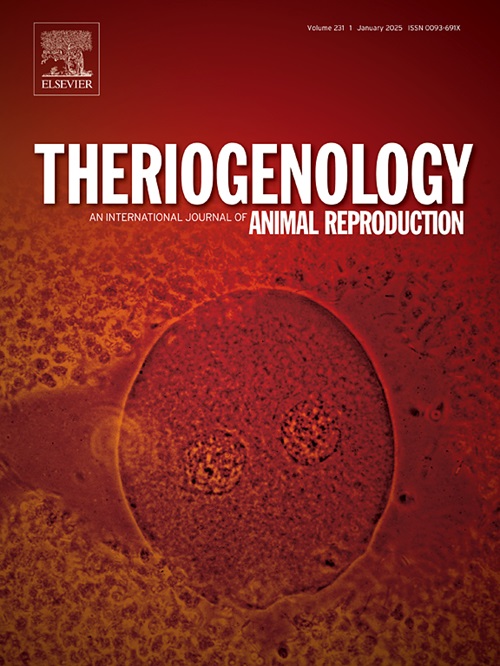产后第四周血总钙浓度继续对奶牛子宫复旧起关键作用
IF 2.4
2区 农林科学
Q3 REPRODUCTIVE BIOLOGY
引用次数: 0
摘要
在本研究中,我们研究了患有或不患有亚临床子宫内膜炎(SCE)的临床健康产后奶牛子宫复旧、血清代谢产物和钙浓度之间的关系。选取43头产后21 - 29天的荷斯坦奶牛,选取无临床子宫内膜炎或其他临床产后疾病的奶牛。生殖道测量包括子宫颈和子宫角的直径,血液样本分析包括血清总钙、总胆固醇、甘油三酯、非酯化脂肪酸和β-羟基丁酸。使用细胞刷收集子宫内膜细胞学样本,评估产后21-29天子宫内膜多形核白细胞(pmn)的比例。结果显示SCE(定义为子宫内膜涂片中有5% PMNs)与子宫尺寸或血清钙水平没有关联。然而,考虑胎次和产后天数随机效应的一般线性模型表明,较低的血清钙浓度与较大的宫颈和子宫角直径相关(P <;0.001),提示子宫结构尺寸与钙浓度呈线性关系。对于所有其他代谢物,没有发现与宫颈和子宫角直径的关联。这表明血钙在产后后期支持子宫复旧的作用。有趣的是,子宫内膜样品中的PMN% (SCE的特征)与子宫大小的变化无关,这表明其他与围产期相关的因素而不是血清钙水平在产后第四周影响SCE的发展。本文章由计算机程序翻译,如有差异,请以英文原文为准。
Blood total calcium concentrations in the fourth week postpartum of dairy cows continue to play a key role in uterine involution
In the present study, we examined the relationship between uterine involution, serum metabolites and calcium concentrations in clinically healthy postpartum dairy cows with or without subclinical endometritis (SCE). A cohort of 43 Holstein cows, sampled between 21 and 29 days postpartum, was selected based on the absence of clinical endometritis or other clinical postparturient diseases. Reproductive tract measurements included the diameters of the cervix and uterine horns, and blood sample analyses included serum total calcium, total cholesterol, triglycerides, non-esterified fatty acids, and β-hydroxybutyrate. Using the cytobrush, endometrial cytology samples were collected to assess the proportion of endometrial polymorphonuclear leukocytes (PMNs) at 21–29 days postpartum. Results indicated no association between SCE, defined as >5 % PMNs in endometrial smears, and either uterine dimensions or serum calcium levels. However, a general linear model, accounting for random effects of parity and days postpartum, demonstrated that lower serum calcium concentrations were associated with greater cervical and uterine horn diameters (P < 0.001), suggesting a linear dependence of uterine structural dimensions on calcium concentration. For all the other metabolites, no associations were found with cervical nor uterine horns diameters. This indicates blood calcium's role in supporting uterine involution during the late postpartum period. Interestingly, the PMN% in endometrial samples (characteristic of SCE) did not correlate with changes in uterine size, suggesting that other factors related to the periparturient period rather than serum calcium levels influence the development of SCE in the fourth week postpartum.
求助全文
通过发布文献求助,成功后即可免费获取论文全文。
去求助
来源期刊

Theriogenology
农林科学-生殖生物学
CiteScore
5.50
自引率
14.30%
发文量
387
审稿时长
72 days
期刊介绍:
Theriogenology provides an international forum for researchers, clinicians, and industry professionals in animal reproductive biology. This acclaimed journal publishes articles on a wide range of topics in reproductive and developmental biology, of domestic mammal, avian, and aquatic species as well as wild species which are the object of veterinary care in research or conservation programs.
 求助内容:
求助内容: 应助结果提醒方式:
应助结果提醒方式:


